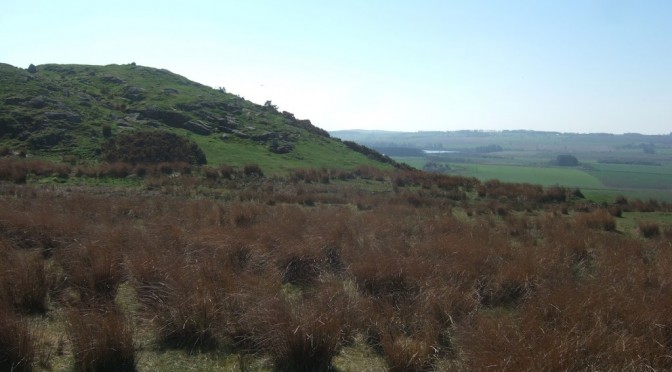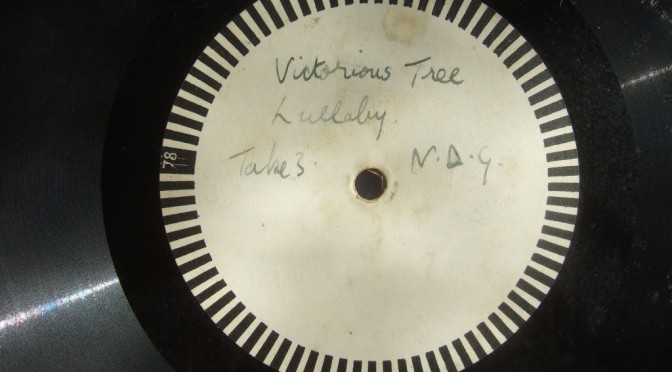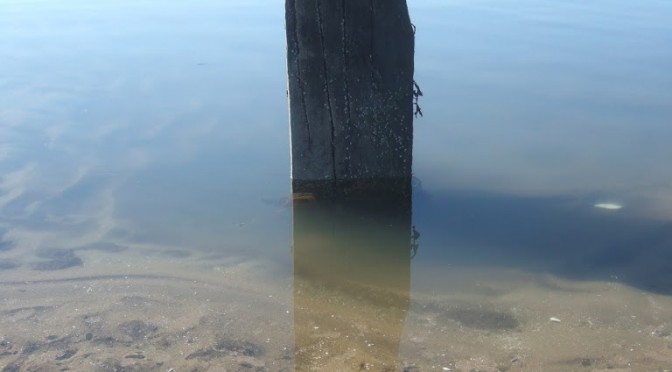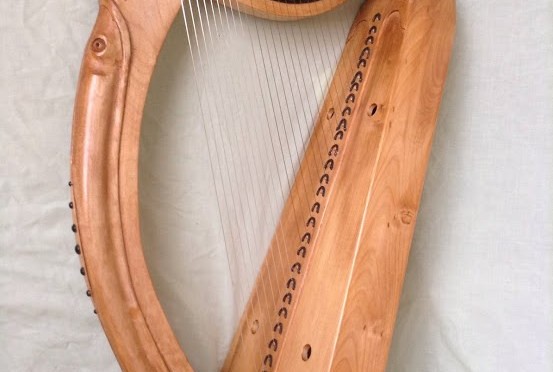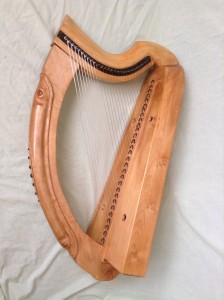This morning I was up Drumcarrow Craig. There are great views of the whole of East Fife and beyond. I looked for the prehistoric hut circles marked on the OS map but I didn’t find them. However the ruins of the broch next to the trig point are very clear to see – must have been an impressive tower standing right on the highest point.
news
The oldest recordings of early Irish harp music?
I have acquired two discs which I think might be the oldest recordings of early Irish harp music, recorded in April 1937. I have not yet played them to hear what is on them – I am still trying to source a suitable stylus for my turntable.
They are one-off lacquer gramophone records, also known as transcription discs – the 1930s equivalent of a cassette tape, for direct recording as a one-off copy. These are not reproductions or duplicate pressings so are almost certainly the only copies that exist of these takes.
Here’s the handwritten label of one of the discs, a double-sided 10-inch disc:
And here is the second record, a 12 inch single-sided disc:
…the small, metal-strung variety [of harp], favoured in Ireland, and the Highlands of Scotland, under the name of Clarsach. I never ceased to thank him [Arnold Dolmetsch] for producing these most fascinating of instruments, whose suavely tuneful music rejoices the heart and charms the senses. One day when I was recreating myself with one of these little instruments, a neighbour who had asked if she might use our telephone, came running into the music room, exclaiming: ‘Oh, what are those lovely sounds? That is the kind of music I want to hear when I am dying!’
From Mabel Dolmetsch, Personal Recollections of Arnold Dolmetsch, RKP, 1957, p148
Cathedral recitals 2013
Historic Scotland have confirmed the dates and times of my harp recitals at St Andrews cathedral ruins here in St Andrews, Fife.
Due to funding cuts at Historic Scotland we are only running two events this year. They will be on the first Thursday of July and August – 4th July and 1st August, at 12.45pm.
For more information please see my cathedral recitals web page.
Edinburgh Harp Festival

This is a portrait of harpmaker Tim Hampson, with the replica Erard single-action pedal harp that he made – one of the best harps at the harp festival each year in my opinion.
This is a photo (taken by Karen Loomis) of me playing a very interesting harp that was at the Telynau Vining stand. It is a Welsh triple harp made by the Llandudno maker Hennesy Hughes (I think) in the late 19th century. I was very keen to play this harp as it is set up for left-orientation player (right hand bass, left hand treble), with the bass singling out to the right side. It was really a delight to try this harp – I usually have great troubles playing triple harps as they are almost always set up for right hand treble, left hand bass playing.
More info about this harp from Camac.
Tarbh
My new CD released today features five solo harp tracks of late 17th or early 18th century music attributed to a great local hero of the West of Scotland – Raghnall Mac Ailein Òig. These grand formal tunes come from the pibroch tradition of the pipes, and also from early fiddle and vocal sources, and I have turned them into dreamy, beautiful clarsach meditations. Each tune has a very different atmosphere, and the CD booklet includes five full-page illustrations made by Ealasaid Gilfillan especially for this project. These unique and intense montage images really give you a sense of the meaning of each tune.
For more info, please visit www.earlygaelicharp.info/tarbh
As a companion to the CD I have also made a set of web pages all about Raghnall Mac Ailein Òig – Ronald MacDonald of Morar, said to have lived 1662-1741. The pages include all the references I used as sources for the CD and also include links to a number of fascinating songs and stories on archive audio recordings at Tobar an Dualchais – the online portal for the tape recordings preserved in the School of Scottish Studies in Edinburgh.
www.earlygaelicharp.info/ranald
7 string lyre bridge
My previous reconstructions of the Iron age lyre bridge discovered by archaeologists at Uamh an Ard Achaidh (Skye Pasture Cave) on the Isle of Skye, have interpreted the broken fragment as having only 3 string positions, framed by 4 pyramids along the top of the lyre.
However, it is possible that the flat shoulder on the surviving half of the bridge represents the broken off base of two more pyramids. If this were repeated on the missing other half, that would give a total of eight pyramids with seven string positions.
This week I made a bridge following this plan. I used a piece of yew wood from near St Andrews.
I’ll have both interpretations of the Skye lyre bridge as well as complete student lyres on my Emporium stand at the Edinburgh Harp Festival next week.
Some thoughts on replicas of old instruments
To me the extant surviving instruments are like treasure-houses of detailed specific data about not only the historical instrument design and construction, but also about all other aspects of the historical music-making (because of the presumption that the original instruments were commissioned by discerning musicians).
So I would regard every last detail about the old instruments as having something important to tell us. And as a player investigating the old music traditions, I want a replica harp that is as close as humanly possible to the old museum examples.
Of the two oldest Gaelic harps, the Queen Mary and the Trinity College harp, I would say they are remarkably similar in design and construction, and that similarity points to a shared conservative instrument-making tradition and a shared conservative music-making tradition, covering Ireland and Scotland. Similarities between them I take to be confirmation of that shared tradition; differences between them become specific individual features of that particular instrument. (you can do the same exercise with the later harps but there are more differences then. The Trinity & Queen Mary are by far the most similar pair I would think).
The Queen Mary harp is far easier to consider since a lot more info has been published on it, mainly the study in 1904 by R.B. Armstrong and more recently Karen Loomis’s ongoing study of it which is published in interim in the Galpin Society Journal 2012. The Trinity College harp is far less well studied or published; the information in Armstrong’s 1904 book is a lot more sketchy and has as I understand it at least one misleading error; and there has not been any further more recent published work than that.
 When I commissioned my own harp (which is a copy of the Queen Mary harp) I insisted that my maker simply copy every aspect he could see with as much fidelity as possible, from selection of timber through to decoration and even the idiosyncracies of individual fittings and adjustments. The idea being to end up with a new instrument that was as close as possible to handling the real thing in as many respects as possible. Since then, Karen Loomis’s work producing 3D X-ray models of the instruments and materials analysis, has revealed important structural and decorative information that would have led to some different decisions being made with my copy, but that is part of the learning process, and Karen’s study has directly addressed certain questions which were raised by my commission.
When I commissioned my own harp (which is a copy of the Queen Mary harp) I insisted that my maker simply copy every aspect he could see with as much fidelity as possible, from selection of timber through to decoration and even the idiosyncracies of individual fittings and adjustments. The idea being to end up with a new instrument that was as close as possible to handling the real thing in as many respects as possible. Since then, Karen Loomis’s work producing 3D X-ray models of the instruments and materials analysis, has revealed important structural and decorative information that would have led to some different decisions being made with my copy, but that is part of the learning process, and Karen’s study has directly addressed certain questions which were raised by my commission.
When I worked with David Kortier on the HHSI Student Trinity Harps, this was a somewhat different project. The initial aim here was simply to obtain a set of affordable harps for use in summer school classes. We were not satisfied with any commercially available models so we approached Kortier to discuss options and he ended up making a custom student model for the Historical Harp Society of Ireland. The main design criteria for this student harp were that it be affordable and quick to make, but that it present a student in class with the string count, string spacing, ‘feel’, and overall ergonomics of the original harp. So you see there was no attempt made to reproduce the subtleties of construction or decoration; but from the beginning the exact geometry and ergonomics of the strings were the most important thing. This was so that a class student given one of these harps would instantly be learning the finger movements and playing techniques exactly as on a proper replica (i.e. exactly as on the real thing!), even if the nuances of sound and response were not as accurate as could be obtained by a proper replica.
We based the first HHSI Student Harp on the Trinity College harp because it is the Irish national symbol and this seemed appropriate. Kortier had visited Trinity College and inspected and measured the original some time before, so he was able to use a lot more than just the published data; even so there were a number of details that had to be guessed or interpolated simply because the data about the original is not available. I mean the data is there, it exists, but it is locked away inside the fabric of the instrument itself and would need a long term detailed programme of scientific analysis like is happening in Edinburgh, to discover it.
So in summary, reconstructing an instrument from the surviving old instruments really needs a partnership between high-tech scientific analysis of the original, and a highly skilled sensitive craftsman-artist. In practice, you have to compromise and make do with what you can get – most of the compromise to date being on the analysis side I have to say. I hope that the recently published ongoing work in Edinburgh will soon feed into the work of the artist-craftsmen and we start to see really high quality accurate replicas that take on board and accurately reproduce these important new discoveries about the detailed features of the old harps.
Every level of data is vital – from the large scale measurements of height, width, string count and string lengths etc, down to tiny details of alignment and adjustment and profiling, all combine to give a very particular playing experience of the musician with important implications for what is and is not idiomatic for that particular instrument – and as our mission is to rediscover the lost old historical idiom, it seems to me that the idiom of each specific historical instrument (or rather, the imperfectly recreated idiom of each attempted reconstruction) is a vital tool for this. And that means that each reconstruction has to be as close as humanly possible to the specific museum original to have any value in that process.
Fraoch visits Ailill & Medb at Cruachan
[Fraoch] went southwards to his mother’s sister, that is to Boand, in the plain of Bregia; and she gave him fifty black-blue cloaks, whose colour was like the backs of cockchafers, each cloak had four blue ears [or lappets]; and a brooch of red gold to each cloak. She gave him besides fifty splendid white shirts with fastenings of gold; and fifty shields of silver with borders of gold. She gave him a great hard spear, flaming like the candle of a royal house, to place in the hand of each man of his party, and fifty rings of burnished gold upon each spear, all of them set off with carbuncles, and their handles studded with precious stones. They would light up the plain the same as the glittering light of the sun. And she gave him fifty gold-hilted swords, and fifty soft-gray steeds, on which his men sat; all with bridle-bits of gold, with a crescent of gold and bells of silver on the neck of each steed of them. And they had fifty crimson saddles, with pendants of silver thread, and with buckles of gold and silver, and with wonderful fastenings upon them (the steeds); and their riders had fifty horse-switches of Findruine, with a crook of gold upon the head of each horse-switch, in their hands; and they had besides, seven grayhounds in chains of silver, and a ball of gold upon (the chain) between each pair of them. They wore shoes of red bronze (Cred-Uma); and there was no colour which approached them that they did not reflect it. They had seven trumpeters among them, with trumpets of gold and silver, wearing many coloured raiments. Their hair was light golden; and they had splendid white shirts upon them. There were three buffoons preceding the party with silver-gilt coronets upon their heads, and each carried a shield with emblematic carvings upon it; and crested heads, and ribs of red bronze in the centres of these shields; and there were three harpers (cruitire), each with the appearance of a king, both as to his dress, and his arms, and his steed….
[While they were at Cruachan, Ailill asked Fraoch if the harpers would play after dinner.] This was the condition of these [harps]. There were harp-bags (crotbuilcc) of the skins of otters about them, ornamented with coral, (Partaing) with an ornamentation of gold and of silver over that, lined inside with snow-white roebuck skins; and these again overlaid with black-gray strips [of skin]; and linen cloths, as white as the swan’s coat, wrapped around the strings. Harps (Crota) of gold, and silver, and Findruine, with figures of serpents, and birds, and grayhounds upon them. These figures were made of gold and of silver. Accordingly as the strings vibrated [these figures] ran around the men. They [the harpers] played for them then, until twelve men of Ailill’s and Medb’s household died of crying and emotion.
(taken from Eugene O’Curry’s Manners and Customs of the Ancient Irish, vol. 3, pps. 219-222)
Broughty Castle
Today I was at Broughty Ferry public library, playing the harp for the baby and toddler book group. This is great fun as well as being a bit of a challenge – I am expected to accompany while they sing a selection of nursery rhymes, unexpected titles, in unexpected keys, and sung quite fast.
I also visitied the castle, and then walked for about half an hour along the beach to the East. The tide was coming in quite fast and I found this lovely reflection in the groynes with the castle in the background. The hill to the left is the northern tip of Fife.
New harp makers
I’m always interested to encourage instrument makers who are looking to start building good copies of the medieval Gaelic harps, and recently I have heard from two established instrument makers who are branching out into early Gaelic harp territory. Both have chosen the Queen Mary harp as their model – a good choice given the amount of information published about it, especially since Karen Loomis has started publishing her researches now (see Galpin Society Journal, 2012)
Michael King is an instrument maker in England, specialising in lyres, kanteles and related instruments (I have one of his lyres). For him the Gaelic harp is a step up in size and complexity but the completed instrument looks very handsome I think:
More info from his website.
Pedro Ferreira is a Portugese instrument maker who produces exquisite clavichords and other baroque instruments. His Gaelic harp is also based on the Queen Mary harp; this is a slightlier simpler prototype I think. I am very excited to see a luthier with this amount of experience on sophisticated historical instruments turn their attention to our harps.
You can get more from his website or from his Facebook page.
As yet I have not seen either of these instruments in person, and I have not had a chance to play them or listen to them. Both of these harps have followed my ‘student’ stringing regime with brass in the treble and mid-range and sterling silver in the bass. I am sure both of them would benefit greatly from having gold strings in the bass instead of silver!
